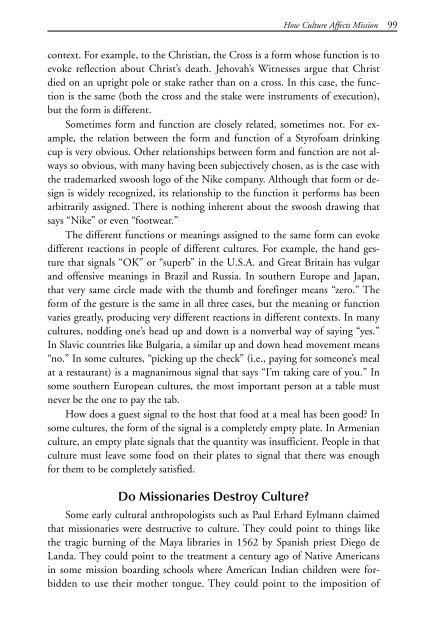discovering missions - Southern Nazarene University
discovering missions - Southern Nazarene University
discovering missions - Southern Nazarene University
You also want an ePaper? Increase the reach of your titles
YUMPU automatically turns print PDFs into web optimized ePapers that Google loves.
245187 Disc Missions ins 9/6/07 1:04 PM Page 99<br />
context. For example, to the Christian, the Cross is a form whose function is to<br />
evoke reflection about Christ’s death. Jehovah’s Witnesses argue that Christ<br />
died on an upright pole or stake rather than on a cross. In this case, the function<br />
is the same (both the cross and the stake were instruments of execution),<br />
but the form is different.<br />
Sometimes form and function are closely related, sometimes not. For example,<br />
the relation between the form and function of a Styrofoam drinking<br />
cup is very obvious. Other relationships between form and function are not always<br />
so obvious, with many having been subjectively chosen, as is the case with<br />
the trademarked swoosh logo of the Nike company. Although that form or design<br />
is widely recognized, its relationship to the function it performs has been<br />
arbitrarily assigned. There is nothing inherent about the swoosh drawing that<br />
says “Nike” or even “footwear.”<br />
The different functions or meanings assigned to the same form can evoke<br />
different reactions in people of different cultures. For example, the hand gesture<br />
that signals “OK” or “superb” in the U.S.A. and Great Britain has vulgar<br />
and offensive meanings in Brazil and Russia. In southern Europe and Japan,<br />
that very same circle made with the thumb and forefinger means “zero.” The<br />
form of the gesture is the same in all three cases, but the meaning or function<br />
varies greatly, producing very different reactions in different contexts. In many<br />
cultures, nodding one’s head up and down is a nonverbal way of saying “yes.”<br />
In Slavic countries like Bulgaria, a similar up and down head movement means<br />
“no.” In some cultures, “picking up the check” (i.e., paying for someone’s meal<br />
at a restaurant) is a magnanimous signal that says “I’m taking care of you.” In<br />
some southern European cultures, the most important person at a table must<br />
never be the one to pay the tab.<br />
How does a guest signal to the host that food at a meal has been good? In<br />
some cultures, the form of the signal is a completely empty plate. In Armenian<br />
culture, an empty plate signals that the quantity was insufficient. People in that<br />
culture must leave some food on their plates to signal that there was enough<br />
for them to be completely satisfied.<br />
Do Missionaries Destroy Culture?<br />
How Culture Affects Mission 99<br />
Some early cultural anthropologists such as Paul Erhard Eylmann claimed<br />
that missionaries were destructive to culture. They could point to things like<br />
the tragic burning of the Maya libraries in 1562 by Spanish priest Diego de<br />
Landa. They could point to the treatment a century ago of Native Americans<br />
in some mission boarding schools where American Indian children were forbidden<br />
to use their mother tongue. They could point to the imposition of

















